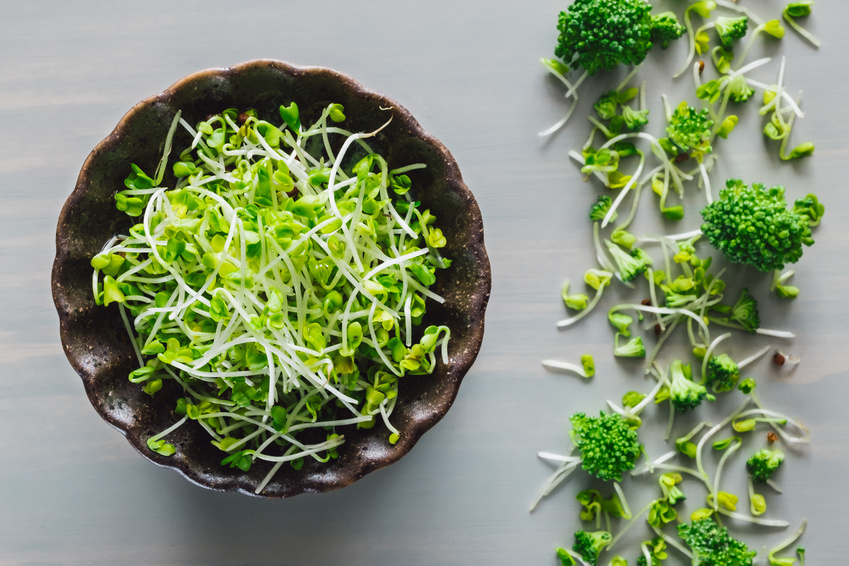
Oil derived from sprouted broccoli seeds is rich in sulforaphane, a compound known to be highly protective of the skin, but also a natural anti-inflammatory agent that may be helpful for those of us who are healing histamine intolerance and accompanying signs and symptoms like inflammation and sunlight sensitivity.
BROCCOLI FOR HISTAMINE
I already loved whole broccoli for its high Vitamin C content, antioxidants, hormone-balancing capabilities (via the compound indole-3-carbinol), fiber, and versatility in cooking. When I learned more about the compound, sulforaphane, present in broccoli and other cruciferous vegetables (and highest in broccoli sprouts) I loved it even more.
The Vitamin C in broccoli already makes it a great antihistamine vegetable to include in your healing histamine diet. But the sulforaphane takes it up to the next level. Not only does sulforaphane act as an antihistamine, but it also has evidence of helping with neurodegenerative diseases, cancer, cardiovascular diseases, inflammatory conditions, and more. It is a powerful compound to include on a regular basis. And if you want to get the most bang for your buck, broccoli sprouts are the way to go. After all, each sprouted seed has all the nutrients and information needed for the growth of an entire broccoli plant. You’d have to eat a lot of broccoli to keep up with the sulforaphane you’d get from just a small handful of sprouts.
And an oil from the sprouted broccoli seeds makes sulforaphane even easier to include on a regular basis.
A SULFORAPHANE-RICH OIL
Broccoli seed oil has been found to be rich in sulforaphane. We already know this compound is highly beneficial to the body — but how do we get it in? The nice thing about having a sulforaphane-rich oil rather than just the whole broccoli or broccoli sprouts is that the oil can be applied topically, as well as ingested. Studies have shown that sulforaphane does indeed enter the body transdermally — right through the skin cells and into the bloodstream. And not only can we get it into our bloodstream via the skin — It actually protects the skin.
Broccoli oil has been shown to protect the skin from damaging UV rays –not by acting as a sunblock or sunscreen, but by increasing protective enzymes in the skin, helping the skin cells protect themselves. This means it doesn’t matter if it washes off. The effects last for several days, rather than a few hours. And the protection remains even after the broccoli oil is no longer on the skin.
Additionally, its high linoleic acid content helps promote the production of ceramides in the skin. Translation: this oil is also anti-ageing.
OTHER BENEFITS OF BROCCOLI OIL
Broccoli oil has long been my go-to hair styling product. Usually, someone with very curly hair, as I have, would rely on silicone based hair styling oils to tame the frizz. While silicones aren’t particularly hazardous to health, they are kind of like putting plastic wrap on your hair and skin. –They don’t let you “breathe.” They can also tend to trap bacteria and oils in when you probably don’t want them there. And since silicones aren’t biodegradable, the cumulative use of these products isn’t great for the environment, either. I had read years ago that this oil mimics silicone when applied to hair, and yup, it totally works on frizz and does it better than the silicone products it replaces.
So, it’s an anti-ageing skin oil, a hair taming oil, and a topical source of sulforaphane for antihistamine, anti-inflammatory effects. What more could a girl want?
HOW TO USE BROCCOLI SEED OIL
I’ve already talked about a few great uses for broccoli oil, but here are some specifics. Definitely keep it in by your bathroom mirror so it’s handy for hairstyling in the morning and to add to your moisturising skin routine at night. You can include the broccoli oil along with one or two of these other great antihistamine & anti-ageing oils.
If you want beautiful, silky smooth hair without any extra effort, you can add a few drops of broccoli seed oil to your favorite conditioner. Then leave the conditioner in your hair a few minutes while in the shower, and you’ll have a shine-enhancing, deep conditioning treatment that rivals a high-end salon or spa.
If you want to easily add some sulforaphane to your diet, add a few drops to your morning juice or smoothie. You can also easily add a couple drops to your histamine-fighting olive oil-based salad dressing. You can even just add the drops on an entire bottle of extra virgin olive oil so that without thinking about it you automatically have sulforaphane-infused oil for your salads.
PRECAUTIONS
Keep in mind that if you have allergic or other reactions to broccoli or thiols, you may also react to broccoli seed oil.
——-REFERENCES——
Akhlaghi, M. & Bandy, B. (2010). Dietary broccoli sprouts protect against myocardial oxidative damage and cell death during ischemia-reperfusion. Plant Foods for Human Nutrition, 65(3):193-9. doi: 10.1007/s11130-010-0182-4.
Bahadoran, Z., Mirmiran, P., & Azizi, F. (2013). Potential efficacy of broccoli sprouts as a unique supplement for management of type 2 diabetes and its complications. Journal of Medicinal Food, 16(5), 375-82. doi: 10.1089/jmf.2012.2559. Epub 2013 Apr 30.
Johns Hopkins Medical Institutions. (2007, October 23). Broccoli Sprout-derived Extract Protects Against Ultraviolet Radiation. ScienceDaily. Retrieved May 20, 2018 from www.sciencedaily.com/releases/2007/10/071022171929.htm
Price, Annie. “Broccoli Seed Oil: The Next ‘It’ Oil for Anti-Aging?” Dr. Axe, 5 Sept. 2017, draxe.com/broccoli-seed-oil/. Accessed 20 May 2018.
Royston, K. J., & Tollefsbol, T. O. (2015). The Epigenetic Impact of Cruciferous Vegetables on Cancer Prevention. Current Pharmacology Reports, 1(1), 46–51. http://doi.org/10.1007/s40495-014-0003-9
Sikdar, S., Papadopoulou, M., & Dubois, J. (2016). What do we know about sulforaphane protection against photoaging? Journal of cosmetic dermatology, 15 1, 72-7.
Tarozzi, A., Angeloni, C., Malaguti, M., Morroni, F., Hrelia, S., & Hrelia, P. (2013). Sulforaphane as a Potential Protective Phytochemical against Neurodegenerative Diseases. Oxidative Medicine and Cellular Longevity, 2013, 415078. http://doi.org/10.1155/2013/415078














